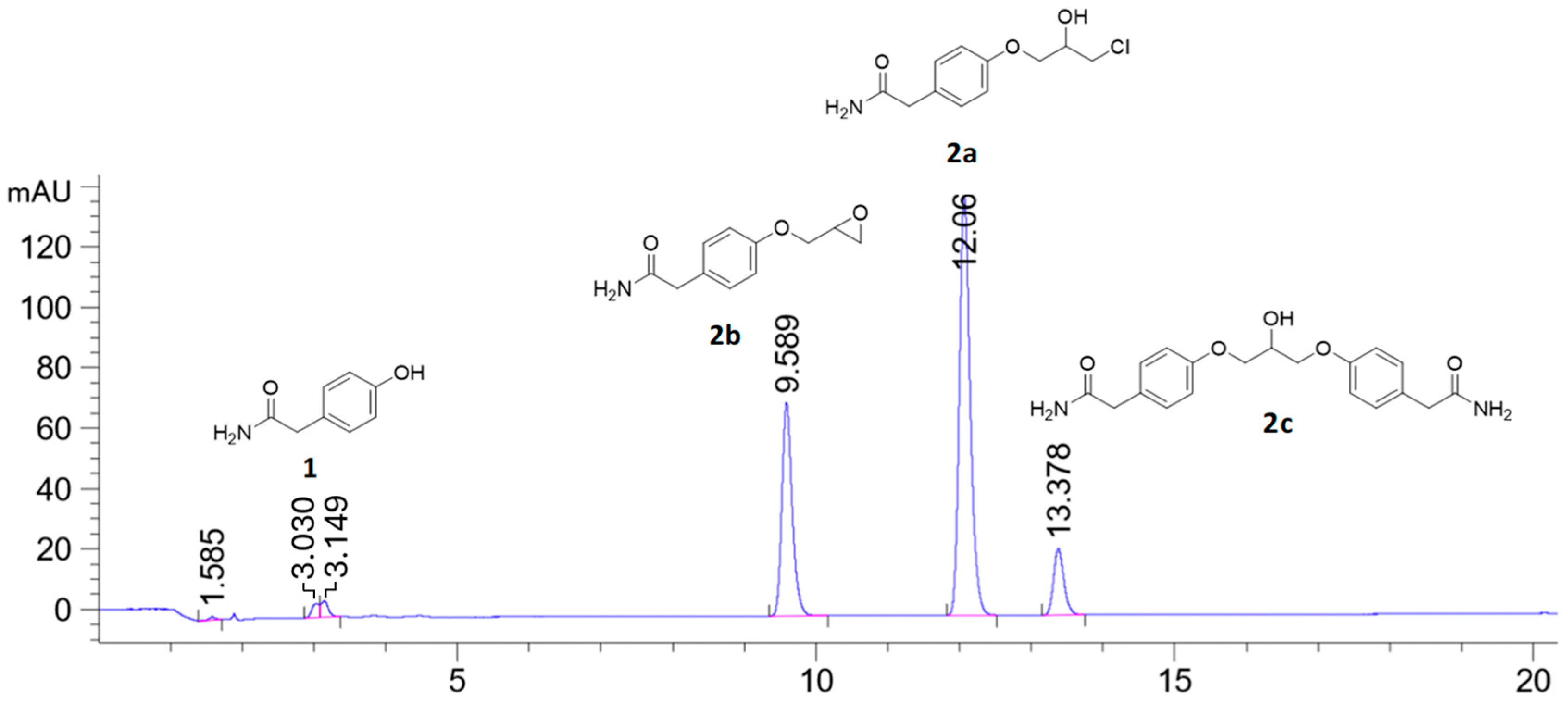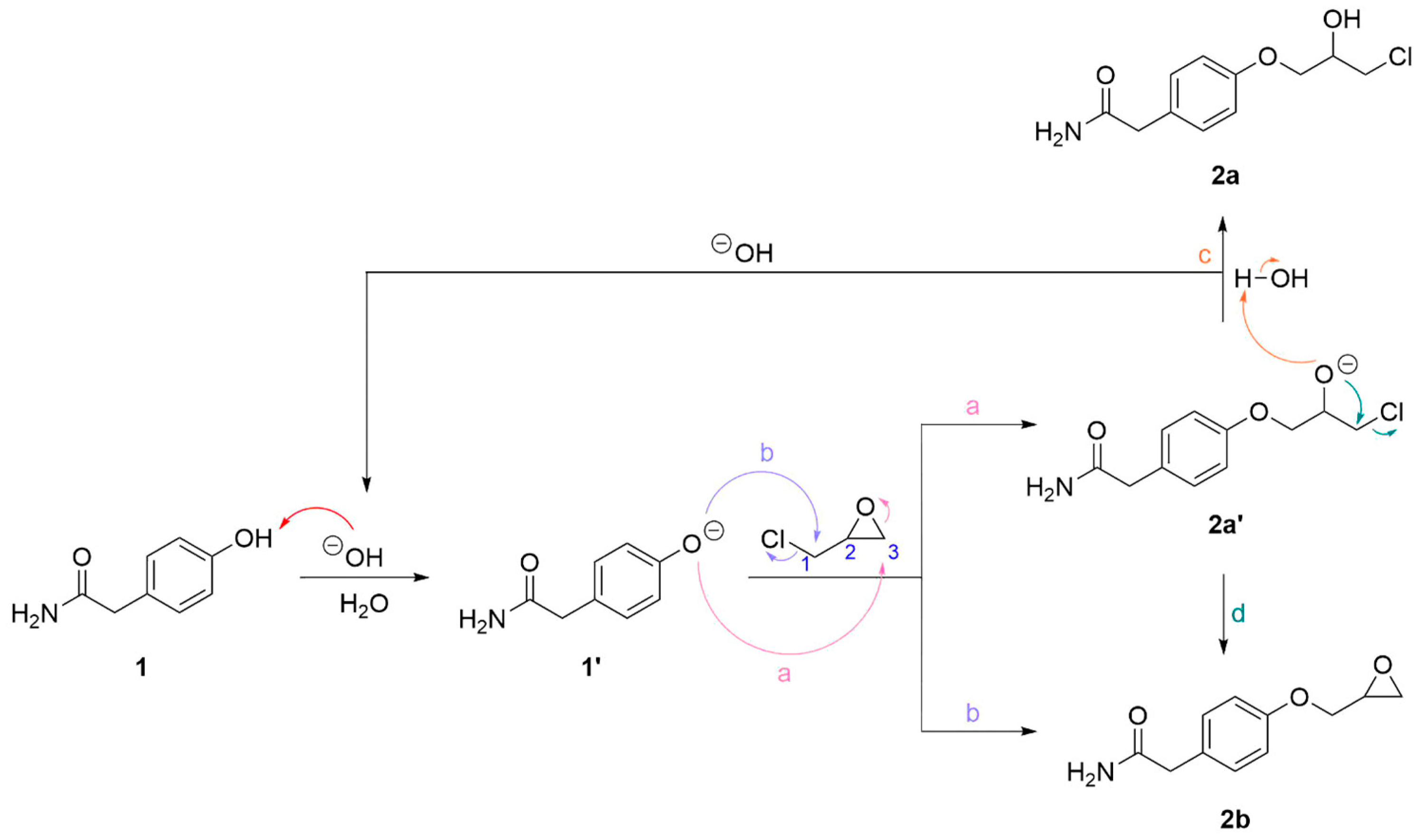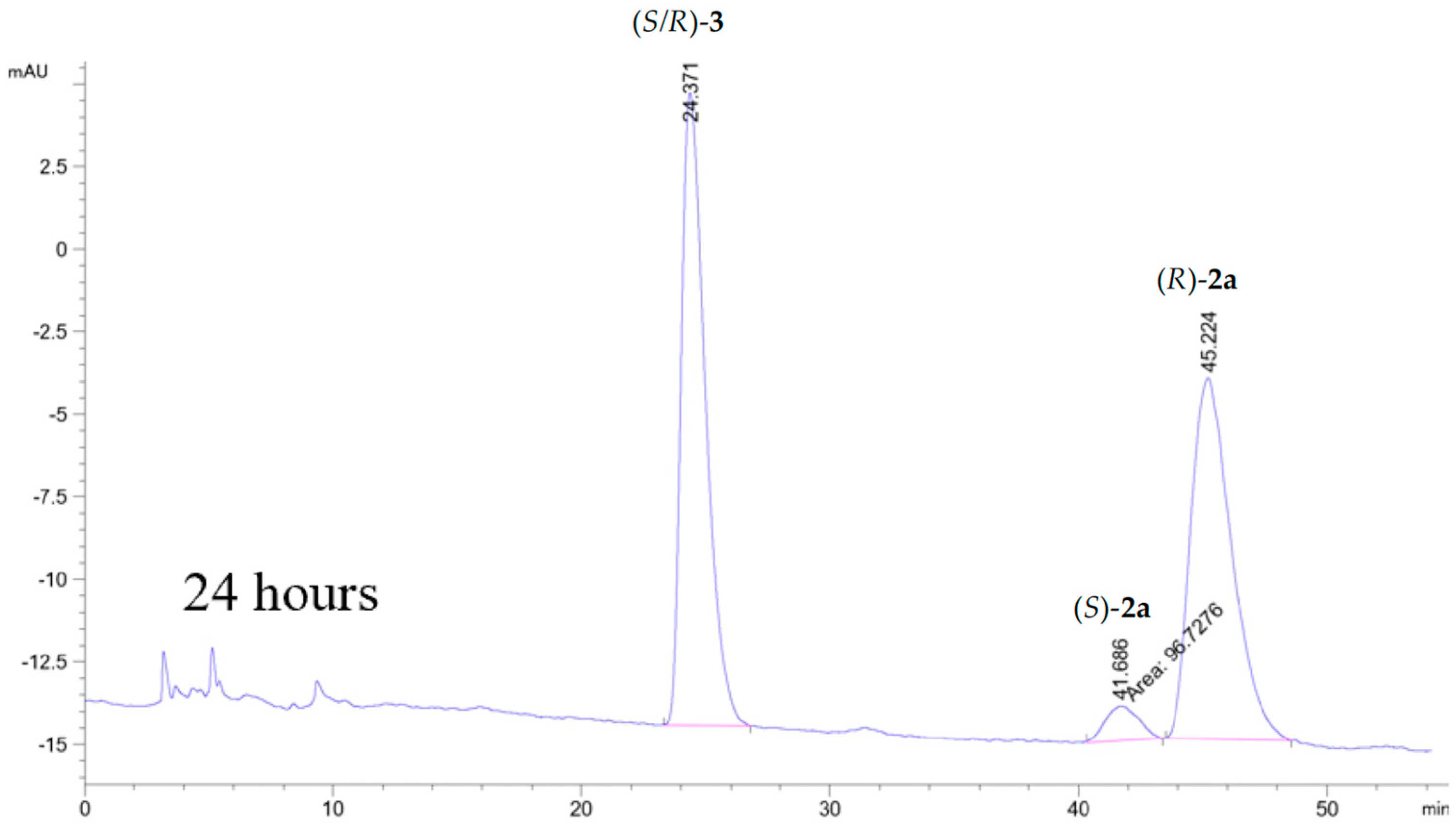Synthesis of Enantiopure (S)-Atenolol by Utilization of Lipase-Catalyzed Kinetic Resolution of a Key Intermediate
Abstract
:1. Introduction
2. Results and Discussion
2.1. Addition of Epichlorohydrin to 2-(4-hydroxyphenyl)acetamide (1)
2.2. Lipase Catalyzed Kinetic Resolution of Chlorohydrin 2a
2.3. Synthesis of (S)-Atenolol, (S)-4
2.4. Synthesis of Racemic Atenolol (4) and Attempt to Resolve 4 with CALA
3. Materials and Methods
3.1. Chemicals
3.2. Enzymes
3.3. General Analyses
3.4. High-Performance Liquid Chromatography (HPLC)
3.5. NMR Analyses
3.6. Mass Spectroscopy Analyses
3.7. Infrared Spectroscopy Analyses
3.8. Specific Rotation Analyses
3.9. Assignment of Absolute Configurations
3.10. Synthesis Protocols
3.10.1. Synthesis of Chlorohydrin 2a and Epoxide 2b
3.10.2. Synthesis of Chlorohydrin 2a by Addition of Lithium Chloride and Acetic Acid to Epoxide 2b
3.10.3. Synthesis of Racemic Atenolol (4) Directly from Phenol 1
3.10.4. Synthesis of (R)-2-(4-(3-chloro-2 hydroxypropoxy)phenyl)acetamide, (R)-2a
3.10.5. Synthesis of (S)-Atenolol, (S)-4
3.10.6. Kinetic Resolution of 2-(4-(2-Hydroxy-3-(isopropylamino)propoxy)phenyl)acetamide, 4
4. Conclusions
Supplementary Materials
Author Contributions
Funding
Institutional Review Board Statement
Informed Consent Statement
Data Availability Statement
Acknowledgments
Conflicts of Interest
References
- Benjamin, E.J.; Muntner, P.; Alonso, A.; Bittencourt, M.S.; Callaway, C.W.; Carson, A.P.; Chamberlain, A.M.; Chang, A.R.; Cheng, S.; Das, S.R.; et al. Heart Disease and Stroke Statistics—2019 Update: A Report From the American Heart Association. Circulation 2019, 139, e56–e528. [Google Scholar] [CrossRef]
- Dansie, L.S.; Bakken, G.V.; Berg, C.L.; Blix, H.S.; Ilic, M.; Litleskare, I.; Sharikabad, M.N.; Skoufa, I.I.; Torheim, S.; Granum, T. Drug Consumption in Norway 2017–2021; Norwegian Institute of Public Health: Oslo, Norway, 2022; p. 172. ISBN 978-82-8406-313-3. [Google Scholar]
- Norwegian Health Information. Available online: www.nhi.no (accessed on 11 February 2024).
- Available online: https://www.databridgemarketresearch.com/reports/global-beta-blockers-market (accessed on 11 February 2024).
- Carlberg, B.; Samuelsson, O.; Lindholm, L.J. Atenolol in hypertension: Is it a wise choice? Lancet 2004, 364, 1684–1689. [Google Scholar] [CrossRef] [PubMed]
- Stoschitzky, K.; Egginger, G.; Zernig, G.; Klein, W.; Lindner, W. Stereoselective features of (R)- and (S)-atenolol. Stereoselective Features of (R)- and (S)-Atenolol: Clinical, Pharmacological, Pharmacokinetic, and Radioligand Binding Studies. Chirality 1993, 5, 15–24. [Google Scholar] [CrossRef]
- Stoschitzky, K.; Lindner, W.; Zernig, G. Racemic beta-blockers—Fixed combinations of different drugs. J. Clin. Bas. Cardiol. 1998, 1, 15–19. [Google Scholar]
- Mehta, S.R.; Bhawal, B.M.; Deshpande, V.H.; Gurjar, M.K. Process for Producing Atenolol of High Optical Purity. Emcure Pharmaceuticals Limited, Pune, India. U.S. Patent 6,982,349 B1, 3 January 2006. [Google Scholar]
- Dwivedee, B.P.; Gosh, S.; Bhaumik, J.; Banoth, L.; Banerjee, U.C. Lipase-catalyzed green synthesis of enantiopure atenolol. RSC Adv. 2015, 5, 15850–15860. [Google Scholar] [CrossRef]
- Agustian, J.; Kamaruddin, A.H.; Aboul-Enein, H.Y. Enantio-conversion and -selectivity of racemic atenolol kinetic resolution using free Pseudomonas fluorescens lipase (Amano) conducted via ransesterification reaction. Rsc. Adv. 2016, 6, 26077–26085. [Google Scholar] [CrossRef]
- Sikora, A.; Chałupka, J.; Marszałł, M.P. The Use of Ion Liquids as a Trojan Horse Strategy in Enzyme-Catalyzed Biotransformation of (R,S)-Atenolol. Catalysts 2020, 10, 787. [Google Scholar] [CrossRef]
- Chałupka, J.; Sikora, A.; Marszałł, M.P. The Utilization of Two-Phase Catalytic System in Enantioselective Biotransformation of Racemic Atenolol. Catalysts 2022, 12, 1068. [Google Scholar] [CrossRef]
- Sikora, A.; Chelminiak-Dudkiewicz, D.; Ziegler-Borowska, M.; Marszałł, M.P. Enantioseparation of (R,S)-atenolol with the use of lipases immobilized onto new-synthesized magnetic nanoparticles. Tetrahedron-Asymmetry 2017, 28, 374–380. [Google Scholar] [CrossRef]
- Sikora, A.; Chełminiak-Dudkiewicz, D.; Siódmiak, T.; Tarczykowska, A.; Sroka, W.D.; Ziegler-Borowska, M.; Marszałł, M.P. Enantioselective acetylation of (R,S)-atenolol: The use of Candida rugosa lipases immobilized onto magnetic chitosan nanoparticles in enzyme-catalyzed biotransformation. J. Mol. Catal. B Enzym. 2016, 134, 43–50. [Google Scholar] [CrossRef]
- Sikora, A.; Sroka, W.D.; Siodmiak, T.; Marszałł, M.P. Kinetic Resolution of (R,S)-atenolol with the Use of Lipases in Various Organic Solvents. Curr. Org. Synth. 2017, 14, 747–754. [Google Scholar] [CrossRef]
- Subhas Bose, D.; Venkat Narsaiah, A. An efficient asymmetric synthesis of (S)-atenolol: Using hydrolytic kinetic resolution. Bioorg. & Med. Chem. 2005, 13, 627–630. [Google Scholar] [CrossRef]
- Darnle, S.V.; Patil, P.N.; Salunkhe, M.M. Chemoenzymatic Synthesis of (R)- and (S)-Atenolol and Propranolol employing Lipase Catalyzed Enantioselective Esterification and Hydrolysis. Synth. Comm. 1999, 29, 3855–3862. [Google Scholar] [CrossRef]
- Lund, I.T.; Bøckmann, P.L.; Jacobsen, E.E. Highly enantioselective CALB-catalyzed kinetic resolution of building blocks for β-blocker atenolol. Tetrahedron 2016, 72, 7288–7292. [Google Scholar] [CrossRef]
- Troøyen, S.H.; Tennfjord, A.L.; Klungseth, K.; Bocquin, L.H.Y.; Jacobsen, E.E. Green Chemo-Enzymatic Protocols for the Synthesis of Enantiopure β-Blockers (S)-Esmolol and (S)-Penbutolol. Catalysts 2022, 12, 980. [Google Scholar] [CrossRef]
- Bøckmann, P.L.; Jacobsen, E.E. Chemo-Enzymatic Synthesis of Enantiopure β-Blocker (S)-Metoprolol and Derivatives. Top. Catal. 2023, 67, 563–571. [Google Scholar] [CrossRef]
- Tjosaas, F.; Anthonsen, T.; Jacobsen, E.E. Biocatalytic resolution of saphenic acid. Substrate preferences for lipases A and B from Candida antarctica. ARKIVOC 2008, vi, 81–90. [Google Scholar]
- Hoff, B.H.; Anthonsen, T. Gas chromatographic enantiomer separation of C-3 and C-4 synthons: Prediction of absolute configuration from elution order and enzymatic resolution. Chirality 1999, 11, 760–767. [Google Scholar] [CrossRef]
- Lystvet, S.; Hoff, B.H.; Anthonsen, T.; Jacobsen, E.E. Chemoenzymatic synthesis of enantiopure 1-phenyl-2-haloethanols and their esters. Biocatal. Biotransfor. 2010, 28, 272–278. [Google Scholar] [CrossRef]
- Anthonsen, H.W.; Hoff, B.H.; Anthonsen, T. Calculation of Enantiomer Ratio and Equilibrium Constants in Biocatalytic Ping-Pong Bi-Bi Resolutions. Tetrahedron Asymmetry 1996, 7, 2633–2639. [Google Scholar] [CrossRef]








Disclaimer/Publisher’s Note: The statements, opinions and data contained in all publications are solely those of the individual author(s) and contributor(s) and not of MDPI and/or the editor(s). MDPI and/or the editor(s) disclaim responsibility for any injury to people or property resulting from any ideas, methods, instructions or products referred to in the content. |
© 2024 by the authors. Licensee MDPI, Basel, Switzerland. This article is an open access article distributed under the terms and conditions of the Creative Commons Attribution (CC BY) license (https://creativecommons.org/licenses/by/4.0/).
Share and Cite
Hansen, M.B.; Tennfjord, A.L.; Blindheim, F.H.; Bocquin, L.H.Y.; Jacobsen, E.E. Synthesis of Enantiopure (S)-Atenolol by Utilization of Lipase-Catalyzed Kinetic Resolution of a Key Intermediate. Int. J. Mol. Sci. 2024, 25, 3497. https://doi.org/10.3390/ijms25063497
Hansen MB, Tennfjord AL, Blindheim FH, Bocquin LHY, Jacobsen EE. Synthesis of Enantiopure (S)-Atenolol by Utilization of Lipase-Catalyzed Kinetic Resolution of a Key Intermediate. International Journal of Molecular Sciences. 2024; 25(6):3497. https://doi.org/10.3390/ijms25063497
Chicago/Turabian StyleHansen, Mari Bergan, Anna Lifen Tennfjord, Fredrik Heen Blindheim, Lucas Hugo Yvan Bocquin, and Elisabeth Egholm Jacobsen. 2024. "Synthesis of Enantiopure (S)-Atenolol by Utilization of Lipase-Catalyzed Kinetic Resolution of a Key Intermediate" International Journal of Molecular Sciences 25, no. 6: 3497. https://doi.org/10.3390/ijms25063497
APA StyleHansen, M. B., Tennfjord, A. L., Blindheim, F. H., Bocquin, L. H. Y., & Jacobsen, E. E. (2024). Synthesis of Enantiopure (S)-Atenolol by Utilization of Lipase-Catalyzed Kinetic Resolution of a Key Intermediate. International Journal of Molecular Sciences, 25(6), 3497. https://doi.org/10.3390/ijms25063497







